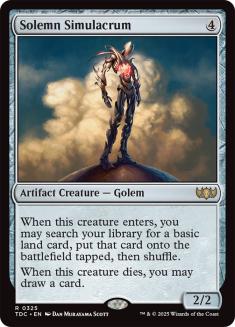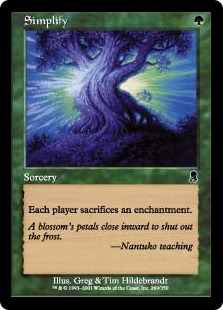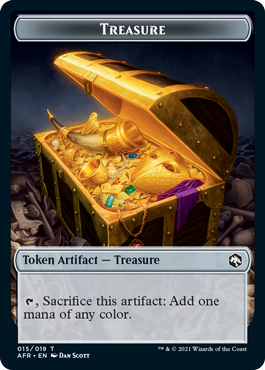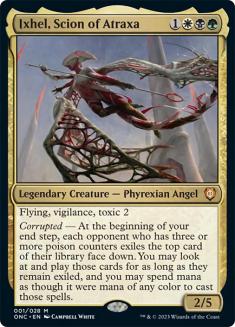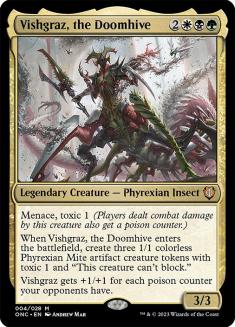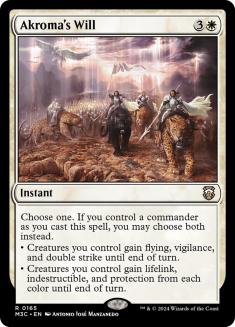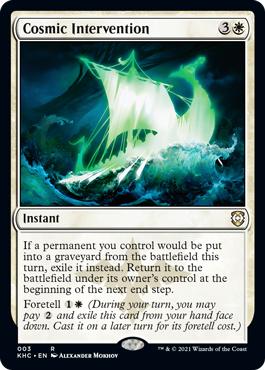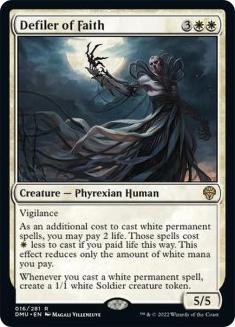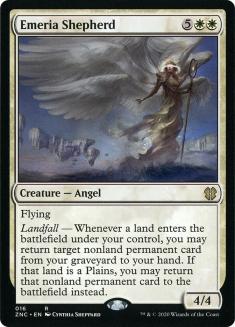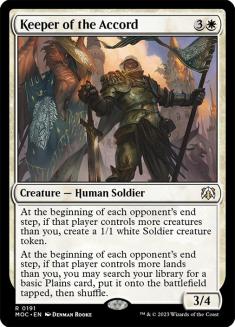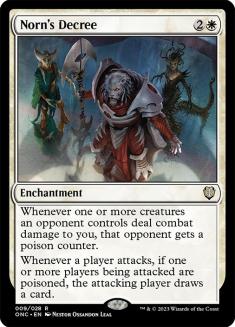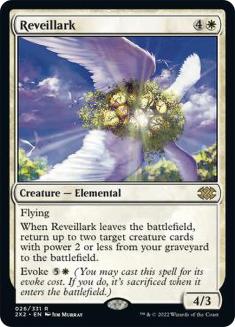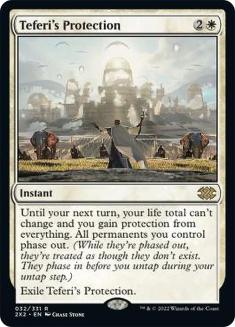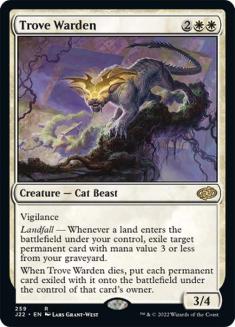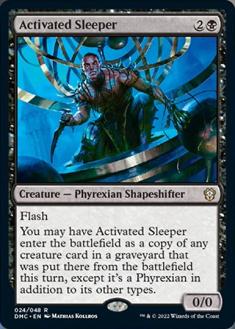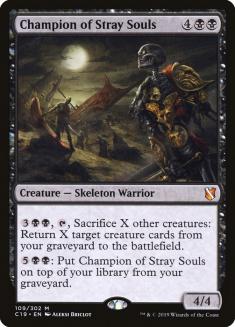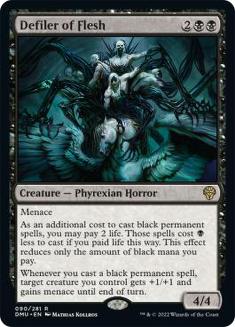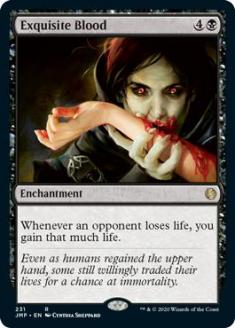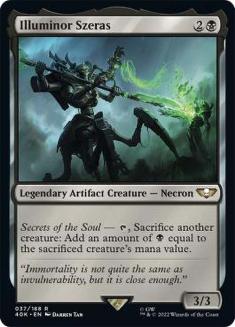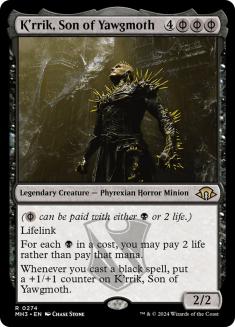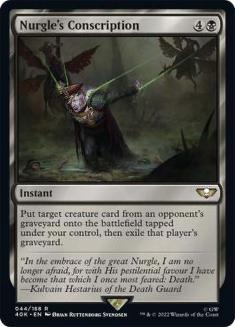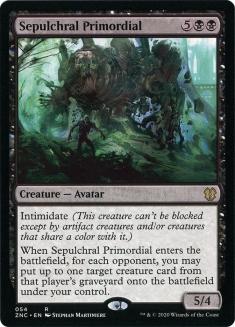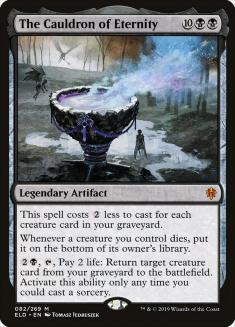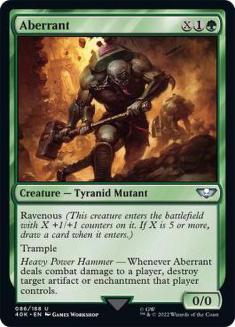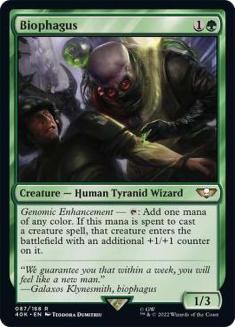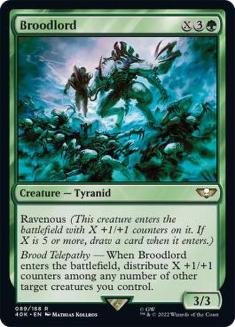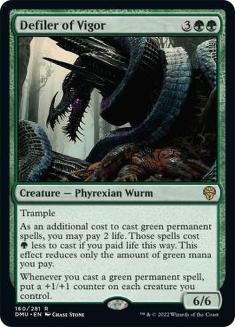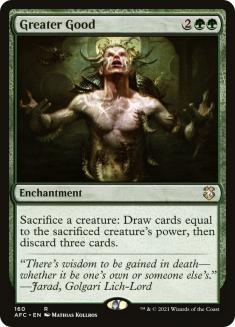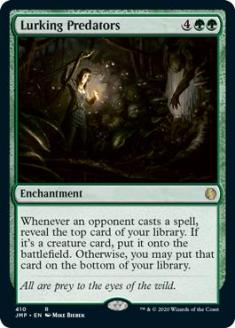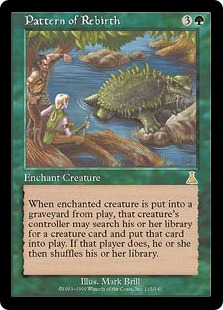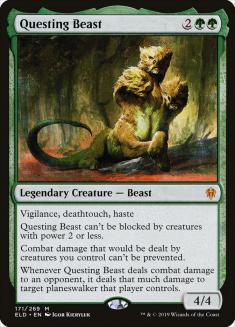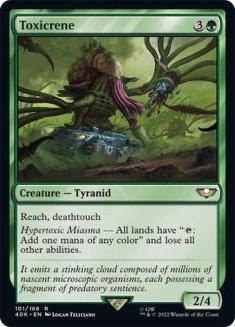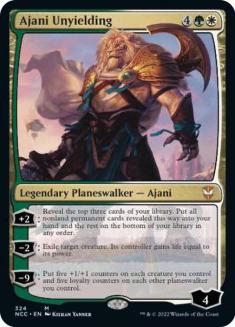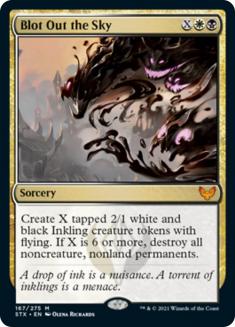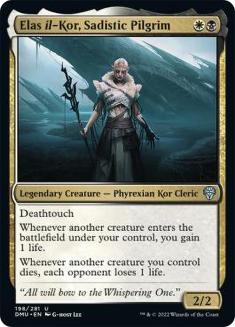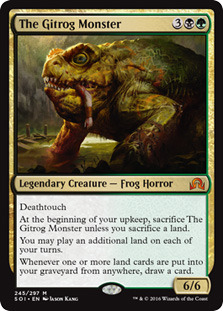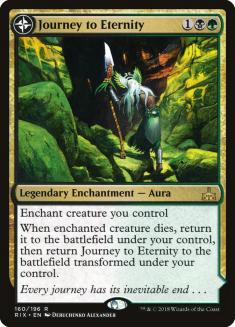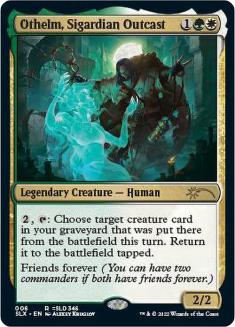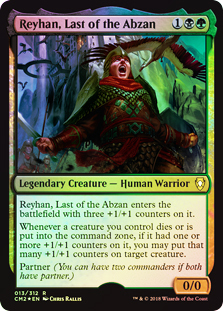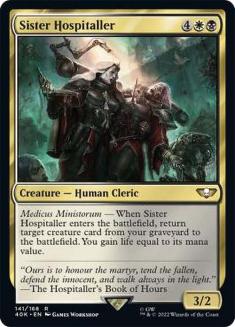Approaching what to build with Phyrexia: All Will Be One led me onto an extremely deep dive into both the set and my card collection. I eventually got around to brewing, but there was this kind of amazing detour into trying to get a handle on the collection and represent it somewhat accurately in the online tool I use, Archidekt. I now have spreadsheets on lots of data, like how many of each shockland I’m playing (not to mention which version is in each deck) or what nonland card I have in the most decks (that’s Solemn Simulacrum, at 29 of 81, about a dozen of which it shouldn’t be in because they’re Do-Over decks, budget decks, etc.).
It was one of those time-consuming labors of love that probably won’t actually make a huge difference, but it was enjoyable despite the seeming drudgery. And I still haven’t gotten to that pile of cards that have been taken out of decks and need to be put back into their proper boxes. That’s one I might be avoiding for a while.
Before we head there, I want to tell you a few things that happened at SCG CON Indy.
SCG CON Indy Report
Fellow Special Guest Gavin Verhey and I did two seminars as well as an informal meet-and-greet that turned into a bit of a Q&A session. The first was a deckbuilding seminar that focused on how to make lists appropriate for meeting the level of the group you’ll be playing that deck with. I have copious notes from this one and would be happy to run it again in the future.
The second seminar was called Creating a Legend. It looked at the design philosophy of legendary creatures and then, with some input from the audience, we built one. We ran through the kinds of things that we’d focus on individually as designers, and then Gavin added some thoughts from a lead designer’s perspective. We really wanted to build something outside the box, which wasn’t specifically tied to a set or world. From the top, we didn’t want something generically powerful, but a commander that would give a deck brewer the opportunity to explore a little.
A design principle we discussed was the simplicity/complexity axis. In short, if your condition is simple, your payoff can be complex. If your condition is complex, the payoff needs to be simple. This way, we don’t create a wall-of-text card that’s difficult to parse. With that under our belts, we moved into what would be cool to create.
Space and the Offbeat
Another design principle which came up is the fact that there’s limited space in the text box of a Magic card. Some folks in the audience came up with really cool ideas that could simply never get printed on a card because there’s not enough room. Despite the fact that there are more words on cards than ever, brevity is still the soul of wit.
We started by about favorite offbeat mechanics and abilities. Phasing, wither, dice-rolling, Wolves, and Walls came up (so did Cephalids, but we considered the support lacking), but the one which struck our fancy was some variation on threshold. Gavin said we couldn’t make a keyword mechanic because threshold is an ability word, not a keyword. We can’t simply reference it like we might with flying or unearth, so we explored the idea of what seven cards in the graveyard meant.
Dual benefits, meaning something for the creature’s controller as well as an opponent (or all opponents), was our next area to explore. We found it compelling for people to want to play with and around the card. By caring about the size of everyone’s graveyards, it opens up a commander that wants to control them. It’s a good thing to consider using many other cards that you wouldn’t normally put into a deck.
The Junderground
After some conversation, we agreed that Jund seemed appropriate color-wise, since we were messing around with the graveyard. We talked about reanimation, goad, milling, delve, and escape. We also went into Jundian mechanics like trample and dealing damage on attacking. After much great back-and-forth with the audience, once we decided what the card does, we even figured out what plane it’s from and a name.
BRG
Legendary Creature—Ogre Advisor
Trample
At the beginning of each player’s combat step, choose target creature that player controls. If you have exactly seven cards in your graveyard, goad that creature. If that creature’s controller has exactly seven cards in their graveyard, that creature gains double strike and trample.
3/3
Breaking Down Ritzia
You’ll see that we opted for the complex condition (which also applies to the controller and their combat) leading to a relatively straightforward payoff. Giving the creature a buff of +3/+3 was also on the table instead of double strike, but we felt like there’d be stronger reasons for players to want the trigger to resolve or not with double strike.
Both sentences of the beginning of combat trigger have a conditional-if clause, meaning that it has to be true both when the trigger goes on the stack and when it resolves; lots of activity can happen in between. The simple act of casting a spell or sacrificing a creature will change graveyard size. Multiple players can have input. All in all, this is a card that there’s a great deal of play in.
The idea of really leaning into the concept of sevens came up—like making Ritzia, who is a Riveteers boss from New Capenna, into a 7/7. That would mean a much higher mana value. If we were heading in the direction of mana value mattering, like with Imposing Grandeur, it might be worth it. We also talked about adding double strike and maybe making her a 5/5, but that would also mean a higher cost. We were committed to getting Ritzia onto the battlefield and doing her thing sooner rather than later, so we opted for the lowest reasonable cost.
A Second Draft
Discussing this initial design afterward, Gavin and I both agreed that it wanted just a little something more. We figured this is what we’d pass to the Casual Play Design team (shout-outs to Sara Mox, Melissa DeTora, and the whole team!) to see if they could come up with that little something extra. I might try to add another triggered ability focusing on double strike, like there being a benefit for a creature with double strike giving its controller a benefit.
It’s wordy, but going back to the somewhat-complex condition, something like whenever a creature deals combat damage to a player for the second time in a turn, its controller creates a Treasure token. My first thought was drawing a card, but that’s probably a little too strong.
Alternately, we could limit it by having there be a payment for the ability: Whenever a creature with double strike (or trample, I suppose) deals combat damage to a player, its controller may pay 1B or 3; if they do, they draw a card and lose one life. This way we still keep it in the vein of each player being able to get a benefit from it. Both of those ideas still seem a little strong for the mana cost, which I’d prefer to stay the same, but it’s how I’d approach working through it.
Creating a Legend was a fun seminar to run, and it’s something I’d do again alongside another designer from Studio X. I hope you enjoyed the somewhat simplified look into the design process and what the seminar produced. Now let’s move into brewing with Phyrexia: All Will Be One.
Building—or Is It Brewing?
I tend to use the two terms interchangeably, but it occurs to me that they have two different meanings. Brewing is the design process, when you try to figure out what you want to do and how to do it. Building is the implementation part, in which you actually craft a complete decklist and then assemble it. I’m okay with saying that just assembling the list and recording it, like putting it into an online tool, qualifies; for me, building will always mean the actual physical assembly, but I understand how your mileage might vary.
When someone asks, “What commander(s) from the new set are you building?”, I’ll always consider the associated commander set to be part of the main. Not counting reprints, that gives us 34 choices from the two. Monocolored decks haven’t interested me in a while. Eventually one will come out that tickles my fancy, but for now I’ll focus on the two- and three-color ones, reserving the fours and fives for special cases.
I normally want to take the road less traveled when it comes to building decks. Even if a commander points us in a direction, I’d like to squeeze a little something different out of it. For Phyrexia: All Will Be One, I’d love to find that sweet spot regarding poison. The mechanic is either downright disgusting to or fear-inducing for a great many players, although I suppose we’re just going to have to get used to it in the post-Phyrexian world.
Picking My Poison
The three that seem to give us the best shot here are Ria Ivor, Bane of Bladehold and the two from the Corrupted Influence deck, Ixhel, Scion of Atraxa and Vishgraz, the Doomhive. Ria Ivor can go into both of the latter, which leads us in that direction. Vishgraz can’t do much other than go wide, which doesn’t lend itself to finding a hidden path.
Ixhel is the way more thought-provoking of the two Abzan choices. It’s lousy for webcam play, though. I know we’re moving into the world of going back to the LGS, but a good percentage of my play outside of going to events like SCG CON is still online. I have a few other decks that only can get played IRL, so maybe it’s not so much of a downside. I really love the idea of Gonti-ing people. Can we build something that intentionally gets folks to three or four poison counters and then stops? Is that reasonable, feasible, and playable?
The other question mark is, could we run Atraxa, Grand Unifier to give ourselves access to the fourth color and still make Ixhel the secret commander? The whole idea seems really cheeky. It also seems like we’d be spending some extra money on a decent manabase. Going with Vishgraz is the right call here. And I’m hoping to actually use some of the few hundred cards I have lying around that I haven’t yet filed away.
Here’s a selection of the stuff I had to pick from as I was brewing (grabbing no more than ten of each):
White
Black
Green
Multicolored
I didn’t really want a good-stuff pile, so I looked to see what might marry with the commander and some of the cards from Phyrexia: All Will Be One. I really wanted something that would get people to three poison counters and then do stuff. There are a few cards with corrupted that are decent, but upon a deep look, the mechanic is built more for Draft than Constructed.
Then the kind of idea hit me that can only play out in a Commander deck.
The Deck
Creatures (25)
- 1 Reveillark
- 1 Lord of Extinction
- 1 Indomitable Archangel
- 1 Phyrexian Swarmlord
- 1 Smothering Abomination
- 1 Impervious Greatwurm
- 1 Kolvori, God of Kinship
- 1 Henrika Domnathi
- 1 Bennie Bracks, Zoologist
- 1 Baba Lysaga, Night Witch
- 1 Defiler of Vigor
- 1 Defiler of Faith
- 1 Elas il-Kor, Sadistic Pilgrim
- 1 Biophagus
- 1 Loran of the Third Path
- 1 Teething Wurmlet
- 1 Ria Ivor, Bane of Bladehold
- 1 Paladin of Predation
- 1 Skrelv, Defector Mite
- 1 Ixhel, Scion of Atraxa
- 1 Contaminant Grafter
- 1 Vivisection Evangelist
- 1 Ravenous Necrotitan
- 1 Basilica Shepherd
- 1 Indoctrination Attendant
Planeswalkers (2)
Lands (36)
Spells (36)
- 1 Pattern of Rebirth
- 1 Rampant Growth
- 1 Kodama's Reach
- 1 Overwhelming Instinct
- 1 Three Visits
- 1 Moss Diamond
- 1 Marble Diamond
- 1 Charcoal Diamond
- 1 Defense of the Heart
- 1 Phyrexian Altar
- 1 Aura Shards
- 1 Chord of Calling
- 1 Hour of Reckoning
- 1 Sprout Swarm
- 1 Bloodchief Ascension
- 1 Eldrazi Monument
- 1 Cultivate
- 1 Dispense Justice
- 1 Conjurer's Closet
- 1 Nissa's Expedition
- 1 Arachnogenesis
- 1 Hour of Promise
- 1 March of the Multitudes
- 1 Akroma's Will
- 1 Inkshield
- 1 Wedding Invitation
- 1 Wedding Announcement
- 1 Union of the Third Path
- 1 Skrelv's Hive
- 1 Goliath Hatchery
- 1 Clever Concealment
- 1 Glistening Sphere
- 1 Geth's Summons
- 1 Norn's Decree
- 1 Anoint with Affliction
- 1 Necrogen Communion

Baba Lysaga, Night Witch got me thinking about it. Then I realized that metalcraft requires three artifacts and we’ll have all those Mites running around. I really leaned into cards that said “three or more,” and then built in some synergy. Then the number three got good to me, so I looked for that, which got me to “third.” When I shoved in God-Eternal Bontu, God-Eternal Oketra, and God-Eternal Rhonas, I figured I might be taking the theme a little too far. I nearly kept Bontu and Oketra, one for the card draw and one for the tokens, but cut them for some mana production and an Overrun effect.
We’ll still get some poison counter kills, but it’s only one direction the deck might take. There’s going wide and there’s draining life with Elas il-Kor, Sadistic Pilgrim. If we’re going to have Pattern of Rebirth and Defense of the Heart, we’ll need some large creatures. I went with Impervious Greatwurm and Lord of Extinction, the latter of which can get irrationally large. Then, we can use Ria Ivor, Bane of Bladehold to make a bazillion Mites by making the super-large creature unblockable with Rogue’s Passage or Wedding Invitation.
In the case of Lord of Extinction, we just deal damage, but sometimes life totals get super-high and it might not be enough. Conjurer’s Closet is in the deck mostly to blink Vishgraz and get more Mites, but I also like the interaction of blinking Wedding Invitation to draw cards until we’re ready for the big hit. The unblockable cards might also get us there with Predation.
A New Kind of Battlecruiser
The deck is pretty battlecruiser, just in a different direction. It’s not really going to kill anyone that quickly, and I intentionally avoided Triumph of the Hordes and Tainted Strike, which I would have included had I wanted to be a little more serious. There’s also very little proliferate because it’s a strategy that already happens with poison; I wanted to do something a little different. Again, it’s the direction a more serious version would likely go.
As I try to frequently do, there’s play built into the deck. It’s hard to just vomit some cards on the table and win. In a few cases there are, but for the most part, we’ll have to figure out what’s going on on the battlefield and then act accordingly. That’s the kind of game I love to play and I’ll keep on playing it.
Always remember we have a channel on the Commander RC Discord server dedicated to discussing my articles. I’d love to hear about features that you’d like to see, material you want more coverage on, ideas for subscriber/Patreon benefits you’d like to see, or even things that you think just aren’t working. Join more than 9,000 friends for discussion of not just this piece, but on a wide variety of topics—both Commander-related and not. See you there.
Visit my Decklist Database to see my Signature Decks, the Chromatic Project, and more!


